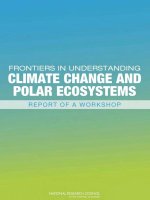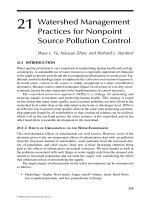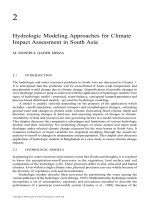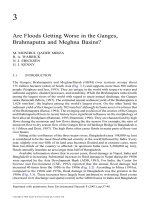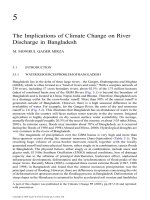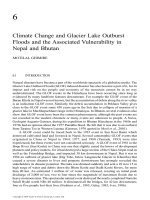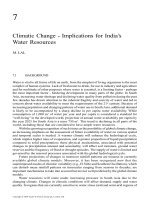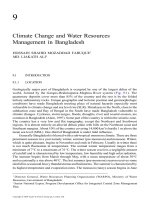Climate Change and Managed Ecosystems - Chapter 21 (end) docx
Bạn đang xem bản rút gọn của tài liệu. Xem và tải ngay bản đầy đủ của tài liệu tại đây (456.63 KB, 16 trang )
411
21
Climate Change and
Terrestrial Ecosystem
Management:
Knowledge Gaps and
Research Needs
I.E. Bauer, M.J. Apps, J.S. Bhatti,
and R. Lal
CONTENTS
21.1 Introduction 411
21.2 Knowledge Gaps and Research Priorities 413
21.2.1 The Climate System 413
21.2.2 Current Stocks and Fluxes 415
21.2.2.1 C Dynamics of Different Ecosystem Types 415
21.2.2.2 Major Non-CO
2
Greenhouse Gases 417
21.2.3 Future Importance of Disturbance 417
21.2.4 Ecosystem Response to Projected Changes 418
21.2.4.1 Agriculture and Forestry 418
21.2.4.2 Wetlands 420
21.2.5 Strategies/Technologies for Adaptation or Mitigation 421
21.2.5.1 Agricultural and Forest Ecosystems 421
21.2.5.2 Wetlands/Peatlands 423
21.2.6 Methodological and Interdisciplinary Issues 424
21.3 Conclusion 425
References 426
21.1 INTRODUCTION
Atmospheric concentrations of greenhouse gases (GHGs) are increasing as a result
of human activities (Chapters 2 and 4). This trend began with settled agriculture,
and conversion of natural ecosystems to cropland, rice paddies, and pasture has
resulted in measurable increases of CO
2
and CH
4
over the past 8000 and 5000 years,
© 2006 by Taylor & Francis Group, LLC
412 Climate Change and Managed Ecosystems
respectively.
1
With the beginning of the industrial revolution, release of CO
2
from
the burning of fossil fuel has added a new dimension to this phenomenon, and rates
of change have continually increased through the 19th and 20th centuries. Current
atmospheric levels of CO
2
are higher than any documented within the past 400,000
years and, without effective mitigation, are projected to reach twice pre-industrial
levels by the end of the 21st century (Chapters 2 and 3).
Although it is hard to separate direct effects of climate change from other global
change impacts, there is mounting evidence that effects of GHG-related warming
can already be detected (Chapters 3 and 4). Increases in the frequency of fire in
Canadian forests over recent decades, for example, may be in part attributable to
climate warming, and there have been significant regional and continental-scale
trends in budding, leaf emergence, and flowering — all phenological events directly
controlled by temperature (Chapter 3). The warming expected to accompany future
increases in atmospheric GHGs will further accelerate such changes, and agronomic
impacts alone have significant implications for global food security, especially given
an expected 50% increase in human populations between 2000 and 2050.
2
Other
projected effects of climate change include a rapid displacement of major biomes
(Chapters 9 and 10) and increased frequency and severity of natural disasters, with
serious impacts on human lives and economic systems (Chapters 2 and 3). Given
these challenges, understanding of climate-change mechanisms and their effect on
biological systems is an important research priority, with land managers and policy
makers needing information from scientists to develop effective strategies for adap-
tation (Chapters 2 and 5) and mitigation (e.g., Chapters 9, 11, 12, 13, 15, and 16).
Much of the human-induced increase in atmospheric GHGs is due to perturba-
tions of the global carbon (C) cycle, with fossil-fuel burning and land-use change
(deforestation) as the primary mechanisms (Chapters 4 and 9). So far, therefore,
human alterations of the biosphere have been part of the problem, contributing ~25%
of all anthropogenic C emissions in the 1990s (Chapter 9). Future cycling of C in
the biosphere will be affected by both human land use and climate change, and the
complexity of climate-biosphere interactions makes net effects hard to predict (e.g.,
Chapters 2, 4, 5, and 9). However, human control over global C cycle processes
could also make the biosphere part of a climate solution, if changes in land use or
management can prevent or offset GHG emissions (Chapters 5, 9, 11, 12, 16).
Drawing on information presented throughout this book, this chapter identifies
key knowledge gaps relating to climate and climate-change effects on agriculture,
forestry, and wetlands. It further points toward research needed to make management
of these ecosystems part of a solution, by identifying gaps in the current understand-
ing of biosphere-based adaptation or mitigation strategies. The list presented here
is only concerned with climate change — biosphere interactions, and with questions
of land use or management where they intersect with this topic. It cannot tackle the
much larger subject of “global change,” or strategies for GHG mitigation that are
not biosphere based. Further, it focuses on science needed to support economic or
policy decision, without making reference to specific market or legislative tools. It
also makes no attempt to include knowledge gaps relating to the development of
economic or policy mechanisms needed to make biosphere-based GHG mitigation
© 2006 by Taylor & Francis Group, LLC
Climate Change and Terrestrial Ecosystem Management 413
a functional and attractive option. For an introduction to this field, the reader is
referred to Chapter 19.
21.2 KNOWLEDGE GAPS AND RESEARCH PRIORITIES
Three overall questions should guide a holistic approach to research into sustainable
resource management in a climate change context:
1. Can terrestrial ecosystems, which have helped to moderate the globally
coupled C-cycle–climate system within a reasonably narrow domain of
CO
2
and climate for at least 420 million years (Chapters 2, 4, and 9), be
managed so as to return the system to its previous narrow domain of co-
variation?
2. Should such mitigation efforts fail, what will be the new C-cycle–climate
domain, and how will terrestrial ecosystems respond? How will agricul-
tural and forest resources be altered, and how will continued increases in
fossil fuel emissions affect active C-pools and C-fluxes?
3. If mitigation is feasible (in the sense of question 1), how can agricultural,
forest, and peatland ecosystems be managed to best provide a net sink
for atmospheric CO
2
, provide the needed food and fiber resources, and
be a part of the solution for overall improvement of the global environ-
ment?
The following sections summarize key research needs to address these overall
questions, including different components of the climate system as well as our
understanding of current ecological conditions, climate change impacts, and adap-
tation or mitigation strategies.
21.2.1 T
HE
C
LIMATE
S
YSTEM
1. What are the processes that determine the role of the biosphere in the
climate system, and how can they be represented in global and regional
circulation models? Climate-biosphere interactions are often nonlinear,
involving complex interactions between energy, biogeochemical, and H
2
O
cycles (Chapter 2). The newest generation of GCMs attempt to incorporate
biospheric feedbacks by including explicit (although simplified) represen-
tations of these processes, but significant challenges remain. These include
especially the scaling of exchange processes that occur over short time-
(hours and days) and small spatial (plant and stand-level) scales up to the
longer (decades and greater) and larger ones (regional and continental)
that effect global patterns. In such scaling, responses that cause significant
changes in ecosystem physiology (plants and soils) or distribution must
be included.
2. What is the relative importance of different forcing factors in driving
observed “recent” changes in temperature? As discussed in Chapter 2,
different climatic forcing factors (solar activity; GHGs; aerosols) vary
© 2006 by Taylor & Francis Group, LLC
414 Climate Change and Managed Ecosystems
independently, and some (e.g., sulfate aerosols from volcanic eruptions)
can have a net cooling effect. Disentangling the relative contribution of
these forcing mechanisms to past climatic changes — and projections of
their likely future variability — are critical to accurate climate projections
and associated estimates of uncertainty.
3. Are trends in means related to the frequency and severity of extreme events,
and if so how? Ecological and societal impacts of climate change depend
both on long-term trends in means (i.e., climate), and on changes in daily,
intra-annual, and inter-annual patterns of extremes (i.e., extreme weather).
Projected increases in the frequency and severity of drought for example
(Chapters 2, 3, and 5) may limit agricultural productivity in some regions,
while outbreaks of insect pests such as mountain pine beetle (Chapters 3
and 17) may spread beyond their present range with a warming of mini-
mum winter temperatures. Ability to project future trends in extremes as
well as trends in means is key to the development of appropriate risk
scenarios, especially at regional and local scales (see next point).
4. How will climatic parameters (especially precipitation and extreme
weather conditions) change at regional and subregional scales? Although
most current climate models agree on the expected direction of global
trends, projected changes especially in precipitation tend to vary at
regional levels (Chapter 2). Moreover, weather patterns (including extreme
events) may shift in space and time, even if large-scale regional means
remain unchanged. Climate-change impacts such as drought, wild fires,
ice storms, and floods are often associated with locally extreme weather,
and management is carried out at local scales. To develop adaptation
strategies that tailor to biotic and economic realities of specific regions,
improved projections (and error estimates) are needed at regional and
subregional scales.
5, Will there be changes in intra-annual climatic patterns? Intra-annual
climatic patterns such as the timing of rainfall and length of growing
season affect crop survival and harvesting schedules, with strong impli-
cations for the productivity of both agricultural and forest systems (Chap-
ters 3, 5, and 17). Significant changes in the timing of phenological events
in recent decades (Chapters 3 and 17) indicate that changes are already
occurring, and the ability to forecast intra-annual patterns of climate
events and their effects on plant phenology and life cycles is important
in developing adaptation strategies (Chapter 3).
6. How will anthropogenic emissions and atmospheric concentrations of
GHGs change over time? GHG emission scenarios are a key element of
uncertainty in climate change projections (Chapter 2). Apart from high-
lighting the potential range of future climatic trends, emission scenarios
are an important component of decision tools, as they allow for a weighing
of likely costs and benefits of specific policy decisions. Realistic emissions
scenarios have to account for biosphere feedbacks as well as human
effects, the latter influenced by both overall population growth and atti-
tudes to land use and fossil-fuel use. Human behavior is complex and
© 2006 by Taylor & Francis Group, LLC
Climate Change and Terrestrial Ecosystem Management 415
hard to predict, but the ability to do so is critical to emission scenarios
and the forecasting of future resource use.
7. How will current buffering capacities (e.g., oceanic, biotic, pedologic) be
altered by changes in climate and further emissions of CO
2
and other
GHGs? As discussed in Chapters 2, 4, and 9, only 40 to 50% of the CO
2
emitted from fossil fuels and land-use change currently remains in the
atmosphere. The rest is returned to terrestrial and oceanic sinks, providing
an important buffering effect against GHG-related climate effects. The
permanence of C taken up by biotic sinks in particular is currently poorly
understood, and the potential for further ecosystem C sequestration is
likely to decrease with increased temperatures (Chapter 4). Understanding
of mechanisms that control the ability of natural systems to buffer anthro-
pogenic emissions is needed to predict future GHG trajectories.
21.2.2 C
URRENT
S
TOCKS
AND
F
LUXES
Determining baseline data for terrestrial ecosystem C stocks and fluxes is an essential
first step to evaluating climate- or human-induced changes. As discussed in preceding
chapters, fundamental gaps in understanding for all sectors still limit our ability to
predict the consequences of different management actions on C fluxes in a changing
environment. A comprehensive understanding of processes that control terrestrial
ecosystem C dynamics and their interactions with the biosphere and hydrosphere is
needed to develop recommendations for land managers. Important research domains
and questions include the following:
21.2.2.1 C Dynamics of Different Ecosystem Types
1. What are current ecosystem distributions and their associated C stocks?
Data of this type are needed for most managed and natural ecosystem
types, including agricultural land, pastures, woodlots/plantations, forests,
and wetlands. Although data exist for some regions and sectors, these are
not complete (see, e.g., Chapter 18), and their accuracy is usually not well
characterized (Chapters 16 and 17). Without basic data on current eco-
system distributions and extent, C-stock assessments will be inaccurate
and projections of change unreliable.
2. What is the current source/sink status of different ecosystem types, and
what are rates of C sequestration under natural conditions (or current
management)? While data on C accumulation and sequestration rates are
increasingly available for some ecosystem types and components, sparse
data networks and high interannual variability confound the calculation
of averages and comparisons between ecosystem types or regions. Com-
prehensive data on all component C fluxes are known only for a few
intensively studied research areas, and are rarely available at the landscape
level. In addition to more data collection, there is an urgent need to develop
reliable spatial and temporal scaling techniques in order to maximize the
usefulness of existing data sets.
© 2006 by Taylor & Francis Group, LLC
416 Climate Change and Managed Ecosystems
3. What are the factors that control C sequestration in managed and natural
ecosystems? Even in cases where rates of C sequestration are documented,
causative factors needed to evaluate the vulnerability of these indicators
are often poorly understood, and existing data tend to be inadequate for
future change predictions. Dependence of C sequestration on nutrient (N,
P, S) and hydrological cycles (Chapter 4) limits our ability to predict
effects of climate change on agricultural ecosystems (Chapter 3), and the
combined effects of temperature and moisture-related variables on the C-
sequestration capacity of peatlands are poorly quantified (Chapter 10).
4. How sensitive are different ecosystem components to climatic variability,
and how can information on total-ecosystem C flux be partitioned into
component processes? Whole-ecosystem measurements of CO
2
exchange
(e.g., from eddy-covariance flux towers) examine the net C balance of a
site under a given set of climatic and environmental conditions, and are
the most direct way to assess the short-term C source/sink status (Chapter
17). However, the response of different ecosystem components to envi-
ronmental variability is often nonlinear, and understanding of climate-
change effects over longer times requires a partitioning of net response
into different component processes (e.g., gross and net primary produc-
tivity, autotrophic and heterotrophic respiration). Methodologies or mod-
els that can partition observed responses and “bridge the gap” between
functional levels of ecosystem C cycling are necessary to understand
current ecosystem behavior, and to predict future responses.
5. How important are belowground processes in net ecosystem C exchange?
Belowground processes are hard to observe or measure and have often
been neglected in studies of ecosystem C dynamics (e.g., Chapter 5). Few
reliable estimates of belowground productivity are available for most
ecosystem types, and factors such as the importance of fine-root dynamics
or mycorrhizal associations in soil organic matter (SOM) turnover (Chap-
ter 17) or the sensitivity of soil microbial communities to temperature and
moisture conditions (Chapter 5) are poorly understood. Belowground
processes control rates of ecosystem C and nutrient cycling and are a key
component of biosphere-climate interactions.
6. How do different disturbance events (harvesting, fire and insect defolia-
tion) affect C dynamics? Ecosystem disturbance leads to biomass C losses
that can be minor (e.g., from a low-level insect attack) or severe (e.g.,
from clear-cut harvesting or stand-replacing wildfire) (Chapters 4 and 9).
Beyond immediate C losses, however, disturbance influences many
aspects of C and nutrient cycling, and future trajectories can depend on
factors such as the fate of dead biomass that remains on-site (Chapters 4
and 9). To fully evaluate the importance of disturbance to ecosystem C
dynamics, data are needed on the short- and long-term effects of specific
disturbance types on different aspects of C and nutrient cycling (e.g.,
effects of fire on above- and belowground C allocation, N cycling, or fine
root dynamics).
© 2006 by Taylor & Francis Group, LLC
Climate Change and Terrestrial Ecosystem Management 417
21.2.2.2 Major Non-CO
2
Greenhouse Gases
1. How are N
2
O emissions from agricultural systems related to hydrology, soil
environment, and nutrient cycling? Nitrous oxide emissions from soils are
dependent on hydrology as well as N availability (Chapter 12), and the
relative importance of these variables in driving emissions is often poorly
understood. More data are needed, for example, on the effect of landscape
structure and management practices on N
2
O emissions, on relationships
between fertilization or N-fixation and N
2
O production, and on the impor-
tance of C/N relationships in controlling N
2
O emissions (Chapter 16). Infor-
mation of this type is critical to evaluate the full GHG impact of alternative
management options, and for the development of mitigation strategies.
2. What are the factors that control CH
4
emissions from wetlands and soils?
Methane is a powerful GHG that is released during anaerobic decompo-
sition in waterlogged soils and wetland systems, with the net flux of CH
4
dependent on factors such as temperature, nutrient status, oxygen avail-
ability, and water-table depth.
3
Although effects of some of these factors
are well documented for some wetland types and systems, their interac-
tions are often poorly understood, and potential trade-offs between lower
CH
4
and higher CO
2
emissions from peatlands under an altered climate
(Chapter 3) cannot be adequately quantified.
3. How are CH
4
emissions from ruminant livestock related to dietary com-
position and genotype? Although manure can be an important source of
CH
4
especially in intensive livestock systems, most livestock CH
4
emis-
sions are due to microbial digestion of cellulose by either fore- or hindgut
fermentation. Many studies have shown clear effects of feed or pasture
composition on CH
4
production (Chapters 12, 13, and 15), but the influ-
ence of different dietary compounds is often hard to separate, and mech-
anisms that control observed responses are largely unknown (Chapter 12).
The same is true for genetic and physiological factors that control differ-
ences in CH
4
production between individual animals or breeds (Chapters
12 and 13), and all these are basic knowledge gaps that hinder the devel-
opment of mitigation strategies.
21.2.3 F
UTURE
I
MPORTANCE
OF
D
ISTURBANCE
Disturbance and subsequent cultivation or succession are important drivers of land-
scape patterns of C sources and sinks. In managed terrestrial ecosystems, for example,
the current spatial distribution of CO
2
sinks may largely reflect historic patterns of
land-use change, and areas that act as strong sinks may be recovering from recent
anthropogenic or natural disturbance (Chapter 9). Types of disturbance with potentially
significant impact on future C emissions include fire (Chapters 3, 9, 10, and 17), pests
and diseases (Chapters 3, 5, 9, and 17), extreme climatic events (Chapters 2, 3, and
5), permafrost collapse (Chapters 3 and 10), and human land use/land-use change
(Chapters 4 and 9). Key questions relate to the future frequency and severity of different
disturbance events, and to their potential interactions and cumulative effects.
© 2006 by Taylor & Francis Group, LLC
418 Climate Change and Managed Ecosystems
1. What will be the effect of climate change on the frequency and severity
of natural disturbance events? One of the projected effects of climate
change is a change in the frequency and severity of natural disturbance
events such as pest outbreaks and fire (Chapters 3 and 17). However, the
occurrence of such events is highly stochastic and hard to predict accu-
rately in space or time (Chapter 17). To generate appropriate risk scenar-
ios, more data are needed about the role of climate and specific local
conditions in influencing the likelihood and severity of different distur-
bance events (Chapter 5). Resulting probability functions have to be
validated wherever possible, and should be incorporated into stochastic
models for risk analysis.
2. How will patterns of anthropogenic disturbance change with increasing
population pressure and changes in management strategies? Humans have
already affected many aspects of the C cycle-climate system, and human
land use (agriculture/forestry) and land-use change (e.g., deforestation)
are strong forcing mechanisms of biosphere GHG dynamics and C stocks
(Chapter 4). Effects of anthropogenic disturbance are likely to increase
with increasing population pressure, and their accurate forecasting is an
important component of future climate projections (Chapter 2) and bio-
sphere C stocks (Chapter 4).
3. Will there be interactions between disturbance types, and what are the
likely cumulative impacts? Little is known about interactions or cumula-
tive effects of different disturbance types. More data are needed, for
example, on effects of management or land-use patterns on the population
dynamics of pests, or on interactions between forest susceptibility to
disease and fire (Chapter 17). Cumulative effects of multiple disturbances
can severely impact C sink potentials of entire ecosystem types (Chapter
10), and strategies to maximize terrestrial C sequestration should be based
on a firm understanding of relevant processes and mitigation options.
21.2.4 E
COSYSTEM
R
ESPONSE
TO
P
ROJECTED
C
HANGES
Ability to predict changes in ecosystem behavior resulting from future climate
change is crucial to the planning of appropriate adaptation and mitigation strategies.
While overall questions are the same for all ecosystem types, there are differences
between managed (agriculture and many forests) and unmanaged (most wetlands)
systems in both current knowledge and the potential to enhance C-sink capacities
through active management. Consequently, key research gaps differ between these
sectors.
21.2.4.1 Agriculture and Forestry
Climate change and increasing human populations are combined stressors that chal-
lenge policy makers and land managers to ensure food security, especially in devel-
oping countries. To support decision processes, improved knowledge is needed of
the impacts of climate change in agroecosystems, especially in areas of soil quality
© 2006 by Taylor & Francis Group, LLC
Climate Change and Terrestrial Ecosystem Management 419
(Chapter 4) and agronomic productivity (Chapter 5). Forests supply human popula-
tions with building materials, food, and fuel, and are thought to play an important
role in buffering anthropogenic emissions (Chapter 9). At the same time, both the
distribution and productivity of these forests will be altered by climate change, a
fact that has to be considered in developing adaptation or mitigation strategies.
Important knowledge gaps in understanding climate change impacts on agricultural
and forest systems are the following:
1. What are the effects of elevated temperature and precipitation changes
on plant growth, life cycles, and productivity? Variation is a key feature
of biological systems, and different species or cultivars differ in overall
productive potential, tolerance to temperature and moisture stress, and
many life history traits that may be important in a climate change context.
Effects of climatic parameters on productivity and life cycles are an
important knowledge gap, since they affect the selection of appropriate
species/cultivars to maintain productivity under an altered climate (Chap-
ters 3 and 5).
2. How will these factors impact soil processes such as nutrient dynamics
and the structure and functioning of decomposer communities? Faster
rates of nutrient cycling and C mineralization under a warming climate
may offset the effect of increased plant production, leading to a net
decrease in ecosystem (especially soil) C storage (Chapter 4). Effects of
temperature changes have rarely been traced through full biogeochemical
cycles, and impacts on decomposer and microbial communities are not
well known. All these factors are important in trying to predict effects of
future warming on GHG trajectories, or the potential for active manage-
ment to enhance biosphere C stocks.
3. How are climate-change effects exacerbated (or mediated) by specific
local conditions such as nutrient (N, P, S) limitation, high nighttime
temperatures, drought stress, and degraded soils? At the present time,
little is known about interactions between climate change-related variables
(temperature, CO
2
) and other environmental stressors such as radiation
(UV-B), soil degradation, or nutrient limitation (Chapters 3 and 4). Infor-
mation of this type is needed in order to predict effects of climate change
on ecosystem functioning especially at local or regional levels, and to
develop risk scenarios and adaptation strategies.
4. What is the magnitude of the CO
2
fertilization effect, and will it change
over time? As discussed in Chapters 4, 5, and 17, plant responses to
enhanced CO
2
differ between species and environmental conditions, and
whole-ecosystem studies into CO
2
fertilization have only just begun. To
assess whether CO
2
fertilization can partially offset anthropogenic GHG
emissions, long-term data are needed to examine the sustainability of
increased plant production, possible interactions between CO
2
and tem-
perature effects, and the potential for management to enhance the mag-
nitude and duration of CO
2
fertilization. To obtain such data, current
ecosystem-scale studies should be continued wherever possible.
© 2006 by Taylor & Francis Group, LLC
420 Climate Change and Managed Ecosystems
5. How important are extreme events in controlling the response of agricul-
tural and forest systems to climate change? Environmental extremes
(especially flooding or drought) can destroy entire harvests, and they may
limit the potential of some areas to support certain crops (Chapter 5). Data
on the sensitivity and resilience of different species to extreme climatic
events are needed, for example, to select suitable species for food pro-
duction or for afforestation (Chapter 9), and to anticipate management
costs required to support bioenergy crops in a given region.
6. How will the geographic distribution of different forest types change under
a new climate, and how fast will these changes occur? As discussed in
Chapter 9, the distribution of major forest biomes is expected to shift
northwards under a changing climate, but rates of change are hard to
predict from current data. To determine (and manage) future forest C-
stock or bioenergy potentials, information is needed on the climatic sen-
sitivity of different species and life history stages, on the importance of
disturbance in driving range shifts, and on likely response times and
natural capacities for dispersal.
21.2.4.2 Wetlands
Northern wetlands (especially peatlands) contain a disproportionate amount of C
compared to other ecosystem types and are an active sink for atmospheric CO
2
but
a source of CH
4
.
4
As discussed in Chapters 10 and 18, C cycling in wetland is
intricately linked to hydrological processes, making these ecosystems inherently
sensitive to climate change. Unlike agricultural systems and many forests, the large
northern wetland areas of Canada and Siberia are mostly unmanaged, and even basic
information on their C stocks and dynamics is often lacking. Key knowledge gaps
in relation to climate change impacts on the C stocks and GHG source/sink rela-
tionships of wetlands are the following:
1. How will climate change affect wetland hydrology? Many climate-change
projections suggest a drying especially of mid-continental regions (Chap-
ters 2 and 3), i.e., in areas that currently support extensive wetland sys-
tems. Direct effects of drying climates on wetland water tables are poorly
quantified, and areas where climate scenarios predict extreme future
warming and drought tend to be those where human impacts on wetlands
have been highest in the past (Chapter 18). The cumulative effects of
climate change and human land use on wetland hydrology are important
for development of wetland sensitivity ratings and regional assessments.
2. What will be the effects of increased temperatures and often lowered water
tables on productivity and C mineralization in peatlands? As discussed
in Chapter 10, interactions between temperature and water tables and their
net effect on plant production and decay in peatlands are poorly quantified.
Information of this type is urgently needed to predict C source/sink rela-
tionships of peatlands under a changing climate.
© 2006 by Taylor & Francis Group, LLC
Climate Change and Terrestrial Ecosystem Management 421
3. How will climate change affect peatland distribution and botanical com-
position, and what are the consequences of these changes for C cycling?
Changes in peatland distribution and community composition expected
under a changing climate have marked implications for future C cycling
(Chapters 10 and 18). However, little is known about the potential for
plant-driven or hydrological buffering effects, and rates of change (espe-
cially C loss from existing deep peat deposits) are impossible to predict
from current data. Major knowledge gaps include species response rates,
the effect of community change on short- and long-term GHG balances,
and the importance of local factors in peatland establishment and disap-
pearance.
4. How will climate-induced changes in permafrost regimes affect the future
GHG balance of peatlands? Permafrost melt is a widespread phenomenon
in peatlands of boreal western Canada (Chapters 10 and 17) and expected
to increase in the 21st century (Chapter 3). Localized permafrost melt has
been shown to increase C sequestration in peatlands (Chapter 10), but net
long-term effects on C storage and GHG dynamics are far from under-
stood. Major knowledge gaps include effects of widespread permafrost
melt on peatland hydrology, long-term trajectories of organic matter pro-
duction and decay at the ecosystem level, and net GHG effects resulting
from differential responses of CH
4
and CO
2
to permafrost degradation.
21.2.5 S
TRATEGIES
/T
ECHNOLOGIES
FOR
A
DAPTATION
OR
M
ITIGATION
In spite of uncertainties regarding the magnitude and effects of climate-related
changes, scientists and policy makers are faced with the need to develop adaptation
and mitigation strategies. Adaptation attempts to limit impacts of climate change
through anticipatory or reactive management, for example, by implementing mech-
anisms that maintain the productivity of forest or agronomic systems (Chapters 3,
5, and 9). Biosphere-based mitigation involves the adoption of management strate-
gies that prevent or offset GHG emissions (Chapters 5, 9, 11, 12, and 16), making
the biosphere part of a strategy to prevent further atmospheric GHG increases. The
identification of effective technologies for mitigation or adaptation is an important
researchable issue.
21.2.5.1 Agricultural and Forest Ecosystems
1. Development of varieties adapted to specific local conditions. The devel-
opment of high-yielding, high-temperature crop varieties is important espe-
cially in the tropics, where adaptation to climate change is complicated by
added stressors such as soil degradation and increasing population pressure
(Chapter 4). In many other regions, adaptation can be achieved by selection
from existing cultivars (Chapter 5), but mechanisms are needed to facilitate
technology and information transfer to local farmers.
© 2006 by Taylor & Francis Group, LLC
422 Climate Change and Managed Ecosystems
2. Development of effective technologies for the reduction of CH
4
from live-
stock. Altered diets, vaccination/defaunation and development of stock
with naturally low CH
4
production are all potential mechanisms to
decrease CH
4
emissions from livestock. The relative effectiveness of these
different methods needs to be investigated for different livestock systems
(e.g., pasture vs. feedlots; Chapters 12, 13, 16), and easy, affordable
implementations have to be made available to livestock managers.
3. Methods of livestock/pasture management that reduce N
2
O emissions.
Mitigation options to reduce N
2
O emissions from rangeland and pasture
systems include dietary manipulation to decrease nitrogen excretion (espe-
cially in urine), nitrification inhibitors, soil drainage or removal of stock
from wet pasture, and fertilizer management/liming (Chapter 12). The
relative efficacy of different methods needs to be investigated for different
management systems, and positive side effects (e.g., increased animal
efficiency with dietary augmentation; Chapters 12 and 15) need to be fully
investigated.
4. Methods of manure management that minimize GHG impacts. Animal
manure can be a significant source of GHGs, especially in intensive
livestock systems. The mitigation benefits of different manure treatment
options (application, on-farm treatment systems, composting, or storage)
need to be investigated (Chapter 16), including GHG benefits from the
use of manure as an on-farm energy source (Chapter 15).
5. Potential for C sequestration in agricultural and forest soils. Agricultural
and forestry practices that maximize soil C sequestration and retention
often have positive effects on both GHG emissions and plant productivity,
but their relative effectiveness can differ widely between regions (Chapter
19). Short- and long-term C benefits of management options such as no-
till systems (Chapters 4, 5, and 16), various crop rotations (Chapter 16),
different harvesting/site preparation methods (Chapters 4 and 9) or con-
version of cropland to grassland or forest (Chapters 5, 8, and 9) should
be investigated under different climatic and environmental conditions, and
any positive side effects (e.g., increased nutrient retention) more fully
evaluated.
6. Strategies to minimize GHG emissions through the entire cycle of produc-
tion. Efficient techniques are needed to help trace GHG effects through
the entire life cycle of a product or commodity. By identifying “hidden
costs,” such methods can evaluate the full GHG impact of different build-
ing materials (Chapter 9) or land-management practices (Chapter 4), and
they can help to avoid unnecessary emissions. In the context of GHG
accounting, these methods are needed to do complete cost/benefit analysis
and evaluate economic potentials of mitigation options such as biofuels
(Chapter 11), on-farm energy production (Chapter 16), or increased use
of forest products (Chapters 9 and 19).
7. Potential for C sequestration in forests and forest products. Forests are a
major biosphere C pool and play a key role in potential strategies to increase
terrestrial C sequestration (Chapter 9). Research is needed into the feasibility
© 2006 by Taylor & Francis Group, LLC
Climate Change and Terrestrial Ecosystem Management 423
and C-sink potential of afforestation projects in different regions, and into
mechanisms to reduce deforestation. The potential for increased use of
forest products to increase the residence time of sequestered C and avoid
fossil fuel emissions during the production of alternative materials (e.g.,
cement) needs to be more fully evaluated (Chapters 9 and 19).
8. Potential for bioenergy production. Use of bioenergy from agricultural or
forest systems avoids fossil-fuel emissions and has strong potential as a
strategy for GHG mitigation. Research is needed into technologies for the
production and processing of bioenergy sources, and into ways to opti-
mally integrate bioenergy with existing fossil-fuel energy (Chapter 11).
Analysis of both large-scale (e.g., forest management for biofuels) and
small-scale (use of mill/farm waste or livestock CH
4
as an on-site energy
source; Chapters 15 and 16) projects is needed to determine the GHG and
economic benefits of bioenergy solutions.
9. What is the permanence of C sequestered in different GHG mitigation
strategies? The permanence of sequestered C is an important consider-
ation in evaluating the effectiveness of mitigation strategies, and is an
issue that complicates the handling of offset credits in current trading
markets (Chapter 19). Carbon fixed in biomass stocks is quickly returned
to the atmosphere when a crop is harvested, unless it is transferred to a
longer-lived pool such as forest products. However, forest product C fluxes
are hard to trace in space and time, and credit for them is the subject of
ongoing negotiation (Chapters 9 and 19). Carbon fixed in soils and wetland
sediments has high potential permanence (Chapters 10, 16, and 18), but
actual turnover rates are often poorly quantified, and information is needed
on the effects of management on long-term retention (e.g., Chapter 19).
21.2.5.2 Wetlands/Peatlands
1. How can the vulnerability of C in wetlands and peatlands be minimized?
As discussed in Chapters 10 and 18, C cycling in wetlands is intricately
linked to hydrological processes, and information is needed on potential
mitigation options to limit hydrological impacts of climate change. This
is especially true for wetlands already affected by human land use such
as agriculture or large-scale industrial activity (e.g., the oil sands devel-
opment in northern Alberta). Even if such wetlands are not destroyed
directly by human activities, cumulative effects may occur from lowered
water levels and factors such as increased nutrient input or soil erosion.
2. How can the C-accumulation potential of drying peatlands be maximized?
Finnish data indicate that increased tree productivity with lowered peat-
land water tables may help to offset increased soil C losses,
5,6
and affor-
estation of drying peatlands may be a potential mitigation mechanism
under climate change. Data are needed on the economic feasibility and
the short- and long-term mitigation potential of such projects in different
regions, and on the susceptibility of peatland forest plantations to cata-
strophic C losses by fire.
© 2006 by Taylor & Francis Group, LLC
424 Climate Change and Managed Ecosystems
3. How can C accumulation in disturbed peatland sites be restored, and how
can new functional wetlands be created? Active restoration and the re-
creation of functional wetlands can reverse effects of human disturbance
and restore the GHG and environmental benefits of wetland systems
(Chapters 10, 16, and 18). Practical knowledge gaps that limit restoration
projects and assessment of their long-term GHG benefits include the long-
term sustainability of restored water levels, potential effects of invasive
species, and the selection of suitable species complements to maintain
wetland function (or C sequestration) under a changing climate.
21.2.6 METHODOLOGICAL AND INTERDISCIPLINARY ISSUES
Numerous compounding factors complicate the prediction of climate-change effects
on ecosystem C dynamics. Interactions between climate change and altered distur-
bance regimes, for example, or cumulative impacts arising from the joint action of
climatic and anthropogenic change, may produce effects that are hard to predict
from current data. Given the complexity of climate–human–C-cycle interactions,
there is a strong need for integrated data management, and for across-scale and
across-ecosystems studies that look beyond narrow disciplinary interests. Modeling
plays a key role in this process because it can simulate complex phenomena, integrate
different types of data, and bridge conceptual, temporal, and spatial scales. Key
methodological challenges that span different fields of climate-change research are
the following:
1. Development of multimodel, multiscenario approaches to generate climate
projections and conduct risk assessment. Variations in the output from
different models reflect uncertainties in our current understanding of rel-
evant processes and carbon–climate interactions. As discussed in Chapter
5, a multimodel, multiscenario approach is needed to assess likely effects
of climate change at local and regional (management-relevant) scales and
to constrain scenario predictions and their associated measures of uncer-
tainty.
2. National databases and frameworks. There is a pressing need to establish
national databases for information such as C stocks for predominant land-
cover types and classes. National data banks can be an integral component
of regional data banks and can supplement more-detailed local data sets.
Data-access protocols to permit use by researchers, land managers, and
policy makers must be established.
3. Development of methods for the measurement and monitoring of C stocks
and fluxes in a precise, transparent, and credible manner to support
accounting frameworks. There are many practical obstacles to the effective
integration of agricultural, forest, and wetland ecosystems into C account-
ing frameworks. These include, for example, the economic impossibility
of directly measuring local changes in soil C stocks over the short interval
of commitment periods (Chapter 19), and a lack of technologies to accu-
rately measure livestock feed intake or GHG emissions (Chapter 12). The
© 2006 by Taylor & Francis Group, LLC
Climate Change and Terrestrial Ecosystem Management 425
development of practical, cost-effective methods to support accounting
frameworks is critical to the success of these economic mechanisms.
4. Integration of measurements with respect to space and time. Temporal
and spatial scaling techniques are critical to our ability to monitor current
ecosystem C distributions and fluxes and to the prediction of climate
change impacts. As discussed in Chapter 17, an ability to use large-scale
measurements from remote sensing may allow for long-term, cost-effec-
tive monitoring of terrestrial C stocks and dynamics. Development of
reliable methodologies to achieve this is an important research need.
Satellite-derived estimates need to be fully verified against ground data,
and new ground data will be required in some areas.
5. Assessment and propagation of uncertainty. Uncertainties associated with
projections of climate change and climate-change impacts are an impor-
tant component of risk assessment. Methods are needed to more accurately
quantify the uncertainty associated with model estimates, and to propagate
errors through coupled climate and biosphere models, as well as other
assessment procedures (Chapter 17).
21.3 CONCLUSION
Climate change is real. While not all of the changes currently observed are directly
attributable to human causes, several challenges of global significance are directly
or indirectly related to climate change. Food productivity and security; the avail-
ability and safety of water supplies; catastrophic events and their impacts on the
quality of human lives and economic systems — all make climate change a key
phenomenon and challenge of the 21st century. The issues discussed in this chapter
are a summary of major research needs relating to climate change and its interaction
with biosphere processes and management. Beyond the broad conceptual framework
established by the subheadings, points are presented in no specific order, and no
attempt has been made to rank their relative importance. While this may appear as
a major omission to many readers, differences in geography, economies, mandates,
and priorities render a single ranking practically impossible. The way this list should
be used depends on context.
As an obvious example, differences in the importance of methane in GHG
budgets of different countries (Chapter 12) translate directly into differences in the
potential impact of CH
4
-reduction mechanisms relative to those for CO
2
and N
2
O.
Similarly, individual agencies within each country have very specific mandates, and
consequent priorities will differ when it comes to the allocation of funds. Finally,
decisions about adaptation or mitigation strategies in particular are made within
economic and political contexts, and such contexts may vary in space and time.
Countries like Canada that have large forest resources, for example, may have to
weigh the relative benefits of managing forests for timber, C stocks, or biofuel
production (Chapters 9 and 11), and “correct” answers (and consequent research
priorities) may depend on the relative weighting of long- and short-term benefits.
Given likely limits to how much C can be sequestered into Earth’s biota — and
its often limited permanence — strategies to offset emissions through terrestrial C
© 2006 by Taylor & Francis Group, LLC
426 Climate Change and Managed Ecosystems
fixation will only be effective over limited (decadal to century) timescales.
7
During
this critical period, however, they can serve as an important bridging mechanism
while technologies to replace fossil fuel–based energy are put into effect. In the long
term, the only solution to GHG-related warming is to curb fossil-fuel emissions,
and some of the technologies that may help achieve this end are also biomass based
(Chapter 11). This means that biosphere management could be an important part of
future energy strategies, and afforestation projects in particular may yield both short-
and long-term GHG benefits.
Finally, responsible ecosystem management is about more than just GHGs or
carbon. A large number of C sequestration projects, for example, may be econom-
ically unviable in a GHG context alone (Chapter 19), but many yield ancillary
benefits that may justify their implementation. Management practices that increase
C retention in degraded soils, for example, yield both GHG benefits and are a long-
term investment in soil quality (Chapter 4). Management for multiple landscape
attributes such as C stocks, biodiversity, and recreational appeal can complicate
assessments of additionality in an accounting context (Chapter 19); it is nonetheless
responsible ecosystem management. Economic incentives related to C and GHG
accounting are likely to play a key role in future land management strategies, and
scientists have to provide policy makers with the information they need to devise
incentives that promote ecosystem health and sustainability, as well as achieving
effective long-term reductions in GHG emissions.
REFERENCES
1. Ruddiman, W. 2003. The anthropogenic greenhouse era began thousands of years
ago. Climate Change 61: 261–293.
2. Fischer, G. and Heilig, G.K. 1997. Population momentum and the demand on land
and water resources. Philos. Trans. R. Soc. (London) B 352: 869–889.
3. Roulet, N. 2000. Peatlands, carbon storage, greenhouse gases and the Kyoto Protocol:
prospects and significance for Canada. Wetlands 20: 605–615.
4. Walter, B.P., Heimann, M., Shannon, R.D., and White, J.R. 1996. A process-based
model to derive methane emissions from natural wetlands. Geophys. Res. Lett. 23:
3731–3734.
5. Minkkinen, K. and Laine, J. 1998. Long-term effect of forest drainage on the peat
carbon stores of pine mires in Finland. Can. J. For. Res. 28: 1267–1275.
6. Minkkinen, K. Vasander, H., Jauhiainen, S., Karsisto, M., and Laine J. 1999. Post-
drainage changes in vegetation composition and carbon balance in Lakkasuo mire,
Central Finland. Plant Soil 207: 107–120.
7. Smith, P. 2004. Soil as carbon sinks: the global context. Soil Use Manage. 20:
212–218.
© 2006 by Taylor & Francis Group, LLC
